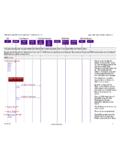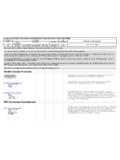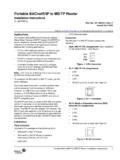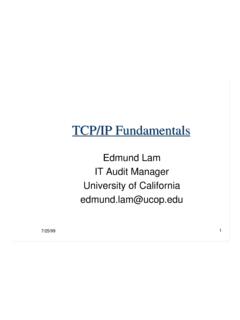Transcription of ARP - Address Resolution Protocol (ARP within a …
1 ARP - Address Resolution Protocol (ARP within a subnet ) subnet 1 IntranetSubnet 2 Host1 Host2 Host3 RouterHost4 ApplicationIP StackLAN Driver 1 LAN Driver 2 LAN Driver 3 Router DriverLAN Driver 18:50 (Page 1)Copyright (c) 2002 Inc. All Rights : ARP within a subnet ARP ( Address Resolution Protocol ) is responsible for mapping from IP addresses to network specific addressing mechanisms. For example, ARP on Ethernet providesmapping between 32 bit IP addresses and 48 bit MAC addresses. ARP is considered to be a low level Protocol and it is generally handled at the device driver level. ARPimplementation is dependent on the underlying network technology. Here we will be describing an ARP implementation for EthernetHost 1 transmits first packet after booting upIP_Packetsource = Host1, destin = Host3 Application sends an IP message destined for Host 3IP Routing Table LookupIP routing software consults the IP routing table to determinethe IP Address of the next hop.
2 In this case the message is beingsent to Host 3 which is directly connected to the same LAN,thus the destination and next hop are the same Address (Host 3)IP_Packetsource = Host1, destin = Host3,next_hop = Host3 The IP packet is passed to the LAN driver for transport over theEthernetCheck ARP Cache for IP Addressto MAC Address translationLAN driver needs to determine the 48 bit MAC addresscorresponding to the IP Destination Address (Host3). The ARPC ache is searched to find the MAC Address corresponding tothe IP PacketIP Address to MAC Address translation could not be found inthe ARP cache so this packet will be discarded. (Assuming thathigher layers will recover from this lost packet)Initiate ARP ProcessingThe Address Resolution Protocol (ARP) will be used todetermine the MAC Address corresponding to the IP addressARP_Requestsource_protocol_addr = Host1,source_hw_addr, destin_protocol_addr= Host3 ARP_Requestsource_protocol_addr = Host1, source_hw_addr,destin_protocol_addr = Host3 ARP sends out the ARP Request packet as a ethernet machines on the ethernet receive the message as theethernet frame indicates that this is an ARP packet.
3 (Here, thebroadcast is shown as multiple messages)Update ARP Cache for source(Host1)Host 2 processes the ARP Request packet. It checks its ARPcache to determine if it has a mapping between the sourceprotocol Address and the source hardware Address (Host1 in thiscase). If a mapping is not found, the ARP cache is updatedDiscard PacketThis ARP request does not target Host 2, so it can now discardthe packetUpdate ARP Cache for source(Host1)Host 3 processes the ARP Request packet. It checks its ARPcache to determine if it has a mapping between the sourceprotocol Address and the source hardware Address (Host 1 inthis case)ARP - Address Resolution Protocol (ARP within a subnet ) subnet 1 IntranetSubnet 2 Host1 Host2 Host3 RouterHost4 ApplicationIP StackLAN Driver 1 LAN Driver 2 LAN Driver 3 Router DriverLAN Driver 18.
4 50 (Page 2)ARP_Replysource_prot_addr = Host3,source_hw_addr, destin_prot_addr =Host1, destin_hw_addrARP_Replysource_prot_addr = Host3, source_hw_addr,destin_prot_addr = Host1, destin_hw_addrSince the Destination Protocol Address in the ARP Requestmatches its own IP Address , it sends back the APR replypacket, addressing it to Host that even though the packet is addressed to Host 1, it will be received and processed by all nodes as the standard ethernet frame contains a field specifying that thisethernet frame contains an ARP packetUpdate ARP Cache for source(Host3)Update ARP Cache for source(Host3)Host 1 now has a mapping from Host 3 IP Address to Host 3 MAC Address . This entry is updated in the ARP Cache In thisprocess, Host 2 has obtained the mapping for Host1 and Host 3for free, without exchanging a single packet!
5 Similarly Host 3has obtained a mapping for Host 1 Host 1 transmits second packet after booting upIP_Packetsource = Host1, destin = Host3 Application sends an IP message destined for Host 3IP Routing Table LookupIP routing software consults the IP routing table to determinethe IP Address of the next hop. In this case the message is beingsent to Host 3 which is directly connected to the same LAN,thus the destination and next hop are the same IP Address (Host3)IP_Packetsource = Host1, destin = Host3,next_hop = Host3 The IP packet is passed to the LAN driver for transport over theEthernetCheck ARP Cache for IP Addressto MAC Address translationLAN driver needs to determine the 48 bit MAC addresscorresponding to the IP Destination Address (Host3).
6 The ARPC ache is searched to find a matching MAC = Host1, destin = Host3 ARP Cache contains the mapping from Host 3 IP Address toHost 3 MAC Address , so the device driver directly sends themessage on the LANARP - Address Resolution Protocol (Proxy ARP) subnet 1 IntranetSubnet 2 Host1 Host2 Host3 RouterHost4 ApplicationIP StackLAN Driver 1 LAN Driver 2 LAN Driver 3 Router DriverLAN Driver 18:50 (Page 3)Copyright (c) 2002 Inc. All Rights : ARP across subnets Using ARP across subnets: ARP should be used only on a single physical network. ARP can also be used (misused?) to handle hosts that are not aware of subnets. Such a hostwould consider a host with the same network id but a different subnet as belonging to the same physical network.
7 Such a host will use ARP to obtain the MAC addresscorresponding to the IP Address in a different subnet . Implementation of Proxy ARP on the router is designed to handle this situationIn this Scenario, Host1 to Host 3 belong to subnet 1 while Host4 belongs to subnet 2. Router connects to both the Subnets and routes packets between themFirst packet for Host 4IP_Packetsource = Host1, destin = Host4An application generates an IP packet for Host4, a machine ona different subnetIP_Packetsource = Host1, destin = Host4 Packet for Host 4 is passed to the LAN DriverARP_Requestsource_protocol_addr = Host1, source_hw_addr, destin_protocol_addr = Host4 Host1 is not aware that Host4 is on a different subnet , itassumes that Host4 is on the same physical network.
8 Thus itsends out an ARP Request for Host4. This broadcast is receivedby the RouterARP_Replysource_protocol_addr = Host4, source_hw_addr = Router_MAC_Addr,destin_protocol_addr = Host1, destin_hw_addrRouter realizes that Host 1 thinks that Host 4 is on the samephysical network. (That's why it is attempting to use ARP).Router recognizes the Host 4 machine as connected to it sends an ARP Reply indicating that its own MACaddress should be used to send packets to Host 4 Second packet for Host 4IP_Packetsource = Host1, destin = Host4An application generates another IP packet for Host4IP_Packetsource = Host1, destin = Host4 Packet for Host 4 is passed to the LAN DriverIP_Packetsource = Host1, destin = Host4, destin_mac_addr = RouterAs a result of the ARP reply, the ARP Cache maps Host 4 IPaddress to routers MAC Address .
9 Thus the packet is forwardedto the RouterIP_Packetsource = Host1, destin = Host4,destin_mac_addr = Host4_mac_addrRouter routes the packet to Host 4 on a different subnet

















